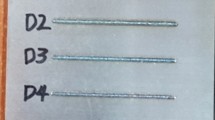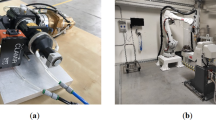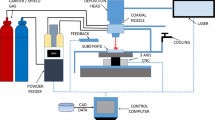Abstract
One of the metallic (additive manufacturing) AM processes is directed energy deposition (DED), which utilizes a machine tool or robotic system for motion control. A laser heat source is used to melt the powder and substrate at the same time after the powder is fed through a powder feeder. Each layer of beads is deposited side by side, and then the layers are stacked over one another. During this process, parts are subjected to intense thermal cycles before reaching room temperature. This rapid heating and cooling, and subsequent expansion and contraction, leads to the generation of tensile and compressive residual stresses within the part. The accumulation of these thermal residual stresses has a detrimental effect on the final product quality. If the residual stresses exceed the yield strength of the material, this will lead to the non-uniform plastic deformation of the substrate as well as cracks, warping, and buckling. One of the influential factors on the amount and gradients of the residual stresses is the deposition or scanning pattern. Therefore, the depositions of the beads in each layer necessitate a careful analysis of the thermal history related to the scanning pattern in order to find the best path for bead deposition. It is desirable to minimize residual stresses and distortions. The purpose of this study was to investigate the thermo-mechanical characteristics for different scanning patterns for laser cladding-based additive manufacturing processes in three types of geometries. This study considered one-way, zigzag, spiral, and raster-angled pattern scans for various component configurations. The fabrication geometries are cross-type, a rectangular surface with a hole, and U-shape. These geometries account for different types of convection-conduction heat diffusion within the parts. The thermo-mechanical responses of the parts to different scanning patterns were assessed using an unsteady finite volume method with a one-way coupling with a finite element structural solver. The scanning patterns were derived from tool path geometry imported from commercial additive manufacturing software (APlus). According to the results, a high conduction zone during the last scan causes a non-uniform cooling rate while the latest scanning area experiences tensile stress. According to the study of different scanning patterns, geometry plays a role in determining which pattern performs best. Cross-type fabrication exhibits the best mechanical response to different scanning patterns. More research needs to be conducted to assess the influences of the geometry in tandem with scanning patterns, and unique AM tool paths may need to be introduced.























Similar content being viewed by others
Availability of data and material
Not applicable.
Code availability
Not applicable.
References
Thompson SM, Bianc L, Shamsaei N, Yadollahia A (2015) An overview of direct laser deposition for additive manufacturing; part i: transport phenomena, modeling and diagnostics. Addit Manuf 8:36–62
Gibson I, Rosen DW, Stucker B, Khorasani M (2021) Additive manufacturing technologies: rapid prototyping to direct digital manufacturing. Springer, Cham
Ding J, Colegrove P, Mehnen J, Williams S, Wang F, Almeida PS (2014) A computationally efficient finite element model of wire and arc additive manufacture. Int J Adv Manuf Technol 70:227–236
Childs THC, Berzins M, Ryder GR, Tontowi A (1999) Selective laser sintering of an amorphous polymer–simulations and experiments. Proceedings of the Institution of Mechanical Engineers, Part B: Journal of Engineering Manufacture. pp 333–349
Dai K, Shaw L (2002) Distortion minimization of laser-processed components through control of laser scanning patterns. Rapid Prototyp J 8:270–276
Nazemi N, Urbanic RJ (2018) A numerical investigation for alternative toolpath deposition solutions for surface cladding of stainless steel p420 powder on AISI 1018 steel substrate. Int J Adv Manuf Technol 96:4123–4143
Nickel AH, Barnett DM, Prinz FB (2001) Thermal stresses and deposition patterns in layered manufacturing. Mater Sci Eng A 317:59–64
Ma L, Bin H (2007) Temperature and stress analysis and simulation in fractal scanning-based laser sintering. Int J Adv Manuf Technol
Ghosh S, Choi J (2007) Deposition pattern based thermal stresses in single-layer laser aided direct material deposition process. J Manuf Sci Eng
Ren K, Chew Y, Fuh JYH, Zhang YF, Bi GJ (2019) Thermo-mechanical analyses for optimized path planning in laser aided additive manufacturing processes. Mater Des 2019:80–93
Ren K, Chew Y, Fuh JYH, Zhang YF, Bi GJ (2020) Thermal field prediction for laser scanning paths in laser aided additive manufacturing by physics-based machine learning. Comput Methods Appl Mech Eng
Ren K, Chew Y, Liu N, Zhang YF, Fuh JYH, Bi GJ (2021) Integrated numerical modelling and deep learning for multi-layer cube deposition planning in laser aided additive manufacturing. Virtual and Physical Prototyping
Zhang Y, Jing H, Xu L, Han Y, Zhao L (2021) Effects of different scanning patterns on nickel alloy-directed energy deposition based on thermal analysis. Virtual and Physical Prototyping 16:S98–S115
Soffel F, Eisenbarth D, Wegener K (2021) Effect of clad height, substrate thickness and scanning pattern on cantilever distortion in direct metal deposition. Int J Adv Manuf Technol
Mohajernia B, Mirazimzadeh SE, Pasha A, Urbanic RJ (2021) Machine learning approaches for predicting geometric and mechanical characteristics for single p420 laser beads clad onto an AISI 1018 substrate. Int J Adv Manuf Technol
ANSYS (2020a) ANSYS Fluent- CFD Software, Release 20.1
ANSYS (2020b) Ansys mechanical APDL theory reference. Tech. rep., ANSYS 2020R1
ANSYS (2020c) ANSYS Static Structural - FEM Software, Release 20.1
Zhang Z, Kovacevic R (2019) A thermo-mechanical model for simulating the temperature and stress distribution during laser cladding process. Int J Adv Manuf Technol 102:457–472
(2021) APlus ®, version 6, CAMufacturing Solution Inc. CAMufacturing Solutions Inc
Acknowledgements
The authors gratefully acknowledge funding from MITACS and CAMufacturing Solutions Inc.
Funding
This work was supported by MITACS Canada. Also, research support from CAMufacturing Solutions Inc. has been received for this research.
Author information
Authors and Affiliations
Contributions
All authors contributed to the study conception and design. Material preparation, data collection, and analysis were performed by Seyedeh Elnaz Mirazimzadeh and Syamak Pazireh. The first draft of the manuscript was written by Syamak Pazireh and all authors commented on previous versions of the manuscript. All authors read and approved the final manuscript.
Corresponding author
Ethics declarations
Ethics approval
The authors declare that this is an original work by them and the data used from previously published publications is cited in the paper. No data, text, or theories by others are presented as if they were the authors’ own (“plagiarism”). The paper is not currently being considered for publication elsewhere.
Consent to participate
Not applicable.
Consent for publication
All authors approve the manuscript and give their consent for submission and publication in The International Journal of Advanced Manufacturing Technology.
Conflict of interest
The authors declare no competing interests.
Additional information
Publisher’s note
Springer Nature remains neutral with regard to jurisdictional claims in published maps and institutional affiliations.
Rights and permissions
About this article
Cite this article
Mirazimzadeh, S.E., Pazireh, S., Urbanic, J. et al. Investigation of effects of different moving heat source scanning patterns on thermo-mechanical behavior in direct energy deposition manufacturing. Int J Adv Manuf Technol 120, 4737–4753 (2022). https://doi.org/10.1007/s00170-022-08970-2
Received:
Accepted:
Published:
Issue Date:
DOI: https://doi.org/10.1007/s00170-022-08970-2




